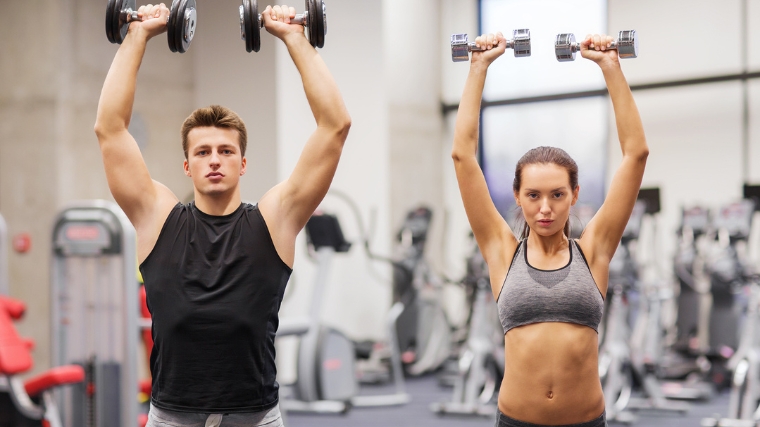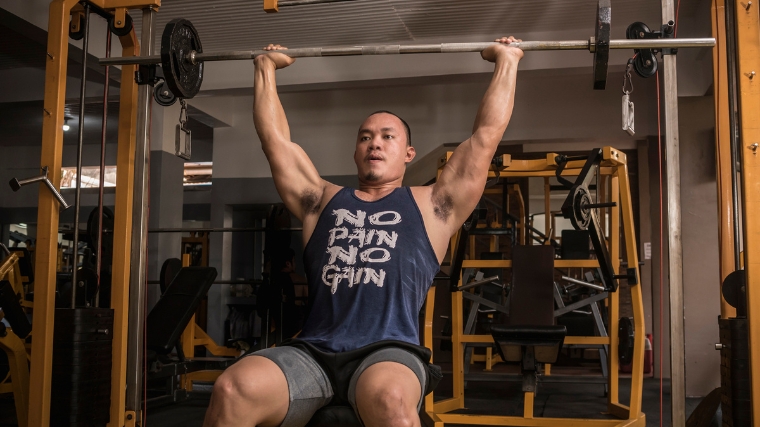Certain aspects of exercise selection tend to dominate the conversation: Do sumo deadlifts beat out conventional pulls? Should you bench with a barbell or dumbbells? Are lat pulldowns better than pull-ups for back growth? The list goes on. But what about something as simple as your setup?
For certain movements, standing or sitting can make all the difference in the world. This is particularly true for the shoulder press — a movement that you may think of as an upper-body exclusive.

Here’s everything you need to know about the seated vs. standing shoulder press (seriously, there’s more going on here than you might think) so you can make an informed decision about which one is right for you.
Why It Matters
Truth be told, standing (or sitting) for your overhead presses won’t dramatically alter the results of the exercise. Everything you do from the waist up — including and especially the motion of your shoulders — is identical in both the seated and standing presses.
If you perform the two exercises properly, you should get comparable results long-term. That said, comfort and sustainability can indirectly affect your gains as well. Standing presses might help you brace your core better, leading to more weight on your bar over time.
On the other hand, performing seated shoulder presses takes less coordination and thus might help you get a better mind-muscle connection. There are also several logistical factors to consider. The devil is, as always, in the details.
When to Do the Seated vs. Standing Shoulder Press
The equipment you have access to, various logistical factors, pre-existing limitations, and, more than anything else, your fitness goals all impact which exercises you should perform. Sitting or standing for your shoulder presses can make all the difference depending on what you want out of your time in the weight room.
For Strength
If you’re in the weight room to improve your pressing strength, you should probably perform the standing shoulder press — but it’s a close call. While standing up, you have the ability to use a bit of isometric leg drive to contribute to your power output in the same fashion that a powerlifter would brace their legs during the bench press.

[Read More: The Best Upper Body Exercises and Workouts]
Moreover, standing up turns the press into more of a full-body strength exercise. Your lower body must contract isometrically to remain still while you push, and the same goes for your core. You should, in theory, be able to lift more weight standing than sitting.
For Muscle Growth
On the other hand, if you’re pressing to grow your shoulders or triceps, your best bet is to go for the seated shoulder press. This removes the ability to utilize your legs and will likely limit how much weight you can work with, but you can be confident that more of the load is applied directly to your delts and arms.
Not having to brace your lower body also affords you more mental energy to focus on your mind-muscle connection and internal cuing. Standing up takes its own element of coordination and focus beyond what you must do with your shoulders.
As a Beginner
If you’re new to the gym and are on the prowl for a good shoulder exercise, the overhead press is a stellar pick. Whether you perform your presses standing or seated is up to you; both work well for newcomers.

There’s more bodily coordination required for the standing shoulder press, particularly if you use dumbbells. You may want to begin by performing the seated shoulder press and, over the course of a few weeks, progress toward pressing from a standing position.
If You’re Short on Time
Time constraints can change the course of your workout, and not always for the better. It’s a simple fact of lifting weights that some movements take more time to complete than others, particularly if those lifts require hotly contested equipment such as a squat rack.
In a busy gym, you may find yourself waiting in line to perform the standing shoulder press out of a rack. If you’re on the clock, that dog won’t hunt. In such cases, your best bet is to perform the seated shoulder press instead. Dumbbells tend to be readily available, and you can sit on any adjustable bench or low seat (or opt out of a back support altogether).
Benefits of the Seated Shoulder Press
These are the selling points of the seated shoulder press: You can isolate your shoulders better than if you stand, it may help you work around certain injuries, and it’s generally easier to learn.
Better Shoulder Isolation
To grow muscle, you need to be able to focus on that muscle, which means taking external factors out of the equation. The more you have to worry about — such as balancing yourself, bracing your core, or incorporating some leg drive — the less you can focus on the target muscle.
By performing your overhead presses while sitting, you can take everything out of the equation except for your shoulders and let you zone in on what matters most: a darn good contraction.
May Help You Work Around Injury
Make no mistake — sitting down for a shoulder press won’t magically spare you of an injury or remedy one that you’re currently dealing with. If you have an achy knee or janky hip, though, taking a seat might enable you to press heavy when you’d otherwise not be able to.
Easier to Learn
The more moving parts you add to an exercise, the more complex it becomes — even if those “parts” aren’t actually in motion. Pressing from a standing position is a skill that takes time to cultivate. On the other hand, seated shoulder presses are more about brute force than technique. (That doesn’t mean you shouldn’t pay attention to your form, though.)
Benefits of the Standing Shoulder Press
Standing shoulder presses will humble you. They’ll also help you develop full-body coordination and strength if you can master the technique and learn to push serious weight properly.
More Loading Potential
Heavy standing presses are among the most formidable challenges you can take on in the weight room — there’s a reason that the sport of strongman is riddled with overhead work. Standing for your presses allows you to load up heavier weights and move those weights with more than just your shoulders.
You need a strong core and rock-solid legs to get a heavy barbell over your head. If you’re looking to move as much weight as possible, definitely stand up for your presses.
Full-Body Stimulation
Any movement that you perform from a standing position will involve your entire body to some degree. After all, you have to hold the bar in your hands during Romanian deadlifts. The same idea applies to the standing shoulder press; your legs have to contract strongly to give you a foundation to press from.
The standing press isn’t strictly a full-body exercise, but your core, glutes, and quads can’t sit on the sidelines during hard sets by any means.
Carries Over to Other Movements
Many strength athletes rely on the strict press as a mainline accessory movement that contributes to their sport-specific performance. Strongmen will strict press as a precursor to heavy log work, and Olympic lifters use the standing press to warm up their shoulders before a heavy clean & jerk session.

Any exercise that recruits a large portion of your overall musculature tends to have solid carryover as well. If you can brace your core while you press a heavy weight overhead, you can brace your core for a heavy front squat or deadlift as well.
Seated vs. Standing Shoulder Press Technique
Despite their apparent differences (many of which fly under the radar and aren’t obvious at a glance), the mechanics of the seated and standing shoulder presses are more or less the same. How you approach them from a technical standpoint depends largely on the equipment you use and what you want out of the exercise in the first place.
What You Need
Seated Shoulder Press
You’ll need to find a shoulder press station with a built-in bench if your gym has one. This will allow you to rack and unrack a barbell while sitting. You can also drag a portable bench over to a squat rack.
If you’re working with dumbbells, you’ll need that same portable seat, but it might also pay to have the assistance of a spotter who can help you get the dumbbells over your head to begin the set.
Standing Shoulder Press
If you don’t want to power clean the barbell before each set, you’ll need to do your overhead presses from inside a squat or power rack — make sure you have enough space over your head.
If you’re doing the standing shoulder press with dumbbells, you will have to perform a dumbbell power clean before each set, which will take some energy. Also, make sure there’s enough open space around you in case you have to drop the dumbbells in an emergency.
Setting Up
Seated Shoulder Press
If you’re using dumbbells, start by sitting in the seat with each weight resting on your kneecaps. “Kick” the dumbbells up to your shoulders one at a time. If you have a spotter, you can have them assist you by guiding your elbows into position.
If you’re using a barbell in a shoulder pressing station, you can set the bar in the hooks either in front of you or behind you, whichever is more comfortable. If the bar is behind your head, have a spotter help you unrack it. If it’s in front of you, rise out of the seat to unrack it manually and then sit back down.
Standing Shoulder Press
If you’re working out of a squat rack, make sure the barbell is set around the height of your clavicles or slightly lower. Place both feet under the bar, grab it with both hands, pull your elbows underneath, and step out.
[Read More: The Best Leg Exercises for Your Next Leg Day]
If you’re performing the shoulder press without the assistance of a rack, you’ll have to power clean the barbell (or dumbbells) from the floor each time.
During Your Set
Seated Shoulder Press
Once you’re in position, press the dumbbells or barbell up and back until the weight is directly above your shoulder. Make sure you’re sitting upright in the seat with your feet firmly against the foot rails.

Avoid scooting your butt forward and leaning back excessively. This will alter which muscles you use during the press and may put unwanted strain on your spine in some cases.
Standing Shoulder Press
The key to success during the standing press is bracing. Make sure that your lower body is entirely locked in from your feet to your abdomen. Actively push against the floor with your legs to engage your quadriceps and glutes.
You can assume whatever stance is comfortable. If you’re performing a strict military press, your feet should be in contact with each other, but understand that this will compromise your balance to some degree. You can take a hip-width or wider stance to give yourself a broader base of support. This may help you generate more force while you press.
Take a Stand (or a Seat)
In the realm of exercise selection, some differences matter more than others. Sumo and conventional deadlifts are quite different in their technique, mobility demands, and muscle activation, for example.
The differences aren’t as stark between the seated and standing shoulder presses, but there’s more at play than just needing higher ceilings if you prefer to press from a standing position. Knowing the nuts and bolts of both movements can help you decide which one is right for you. With that information in hand, you can focus on what really matters — working hard and making gains.
Featured Image: Vladimir Sukhachev / Shutterstock